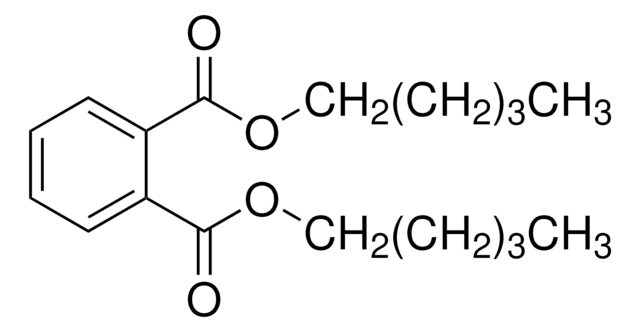31301
Di-n-octyl phthalate
analytical standard
Sinônimo(s):
DNOP, Phthalic acid di-n-octyl ester
About This Item
Produtos recomendados
grau
analytical standard
Nível de qualidade
prazo de validade
limited shelf life, expiry date on the label
técnica(s)
HPLC: suitable
gas chromatography (GC): suitable
densidade
0.980 g/mL at 20 °C (lit.)
aplicação(ões)
cleaning products
cosmetics
food and beverages
personal care
formato
neat
cadeia de caracteres SMILES
CCCCCCCCOC(=O)c1ccccc1C(=O)OCCCCCCCC
InChI
1S/C24H38O4/c1-3-5-7-9-11-15-19-27-23(25)21-17-13-14-18-22(21)24(26)28-20-16-12-10-8-6-4-2/h13-14,17-18H,3-12,15-16,19-20H2,1-2H3
chave InChI
MQIUGAXCHLFZKX-UHFFFAOYSA-N
Procurando produtos similares? Visita Guia de comparação de produtos
Descrição geral
Aplicação
- Soil samples using micellar electro-kinetic chromatography (MEKC), further confirmed by gas chromatography with flame ionization detection (GC-FID).
- Bottled water using gas chromatography coupled to mass spectrometry (GC-MS).
- Plastic toys using gas chromatography with flame ionization detection (GC-FID).
Frases de perigo
Declarações de precaução
Classificações de perigo
Aquatic Chronic 4
Código de classe de armazenamento
10 - Combustible liquids
Classe de risco de água (WGK)
WGK 1
Ponto de fulgor (°F)
228.2 °F - closed cup
Ponto de fulgor (°C)
109.0 °C - closed cup
Equipamento de proteção individual
Eyeshields, Gloves, multi-purpose combination respirator cartridge (US)
Escolha uma das versões mais recentes:
Já possui este produto?
Encontre a documentação dos produtos que você adquiriu recentemente na biblioteca de documentos.
Os clientes também visualizaram
Artigos
A sensitive, quantitative, and reproducible SPME-GC/MS procedure was developed by Supelco for the extraction of phthalate esters from oily food matrices, such as the flavored oils included with ramen noodle kits.
Nossa equipe de cientistas tem experiência em todas as áreas de pesquisa, incluindo Life Sciences, ciência de materiais, síntese química, cromatografia, química analítica e muitas outras.
Entre em contato com a assistência técnica




